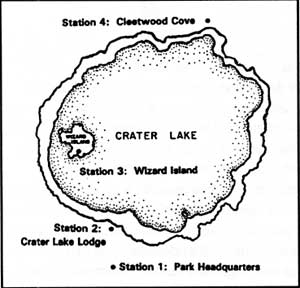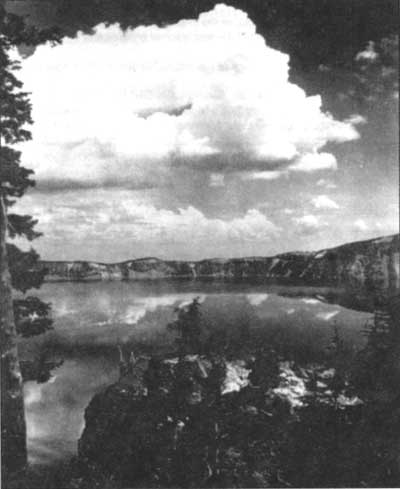The Microclimates of Crater Lake National Park
Visitors at Crater Lake are better informed climatologically speaking than they used to be, but many are still surprised at how the weather varies from place to place in Oregon. Weather systems generally move from west to east across the state. As they do, the systems must cross the Coast Range and Cascade Mountains, Eastward movement lifts moisture orographically to enhance precipitation totals at the highest elevations. Upon crossing the Cascades, the systems begin warming and drying as they descend the eastern slopes of these mountains. This is a “rain shadow” effect and it has created two distinct parts of Oregon. Most populated locations in western Oregon (especially the northwest portion) are notoriously gray and receive 30 to 60 inches of precipitation annually. On the other side of the Cascades, much of eastern Oregon collects a mere 10 to 20 inches of annual precipitation.
Depending upon where you are and when you visit, Oregon’s soggy reputation is misleading. It is true that from October through May, the state can be battered by one Pacific frontal system after another. In the wettest locations, including Crater Lake National Park, several storms can pass without an observable break in the weather. During the summer, however, a dry regime dominates. Several weeks may pass without so much as a drop of rain.
Crater Lake National Park is a microcosm of Oregon. Located along the crest of the Cascade Range in southern Oregon, the park receives heavy precipitation during the winter months at nearly all locations within its boundaries. Annual precipitation amounts at individual stations, however, vary widely depending upon elevation and, to some extent, aspect.
|
Comparison of Precipitation in
* Measurement for March was not available, so the average precipitation of 8.22 inches was induded to represent a more accurate account of the year’s actual precipitation. ** Measurement for July was not available, so the average precipitation of 0.63 inches was induded to represent a more accurate account of the year’s actual precipitation. Reliable comparative data for other years is unavailable for one or more of the above locations. Sources: National Park Service, Crater Lake Division of Natural Resources Oregon State Climate Service, Oregon State University Climate of Crater Lake National Park, G.L. Stemes, 1963. |
The chart compares four years when nearly complete data allowed comparisons of certain stations within Crater Lake National Park. It shows that the collecting station near the Cleetwood Cove parking lot is the driest of the four. It averages 50 percent less precipitation each year than the wettest station among the other three. Wizard Island collected the most precipitation in three of the four years listed, perhaps because this location is very prone to storms from the west and southwest.
Although very prominent in the eyes of visitors, the four stations listed on the chart are probably not good indicators of how varied the weather can be at different places in the park. Watchman Lookout, for instance, is at the very zenith of orographic lift in this section of the Cascades. The weakest of summer rain storms can damage the trail connecting the lookout and Rim Drive, but at the same time not affect visitors enjoying the eastern side of the park. The Pinnacles Overlook may have the honor of being the driest location in Crater Lake National Park, though there is no way to tell without situating weather stations there and in areas like Sharp Peak. The latter is familiar to only the heartiest of backcountry hikers, but the park’s firefighters spend an ample amount of their time around it during July and August.
Storms are infrequent throughout the summer and usually lack the intensity of their winter counterparts. During these events people often crowd into visitor centers, Crater Lake Lodge, or other dry places. What most visitors do not understand is that they could probably be enjoying the outdoors if they only knew the park better. A storm will often only affect the southwest-facing and highest locations, though a view of Crater Lake cannot usually be obtained from Rim Village and the West Rim Drive since these locations are the most likely to be obscured by clouds and mist. There is, however, a 50 percent chance that areas along the East Rim Drive (especially from Cleetwood Cove to the Palisades) will have broken overcast skies and 10 miles or more of visibility.
There are clear advantages to knowing about the effects of microclimates in a place like Crater Lake National Park. You may have more than just a few options during summer days when the weather seems to be less than ideal. It is worth remembering that knowing where it is raining may be more important than knowing whether it will rain!
Gregg Pohll is a seasonal naturalist at Crater Lake who teaches at an elementary school in Chiloquin, Oregon.



